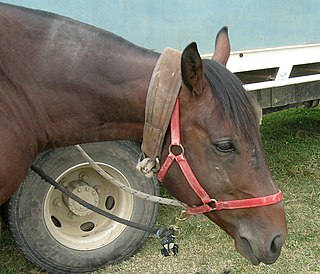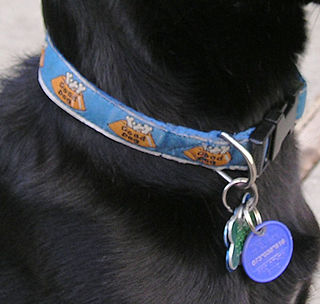 W
WA branding iron is used for branding, pressing a heated metal shape against an object or livestock with the intention of leaving an identifying mark.
 W
WAn animal collar is a device that attaches to the neck of an animal to allow it to be harnessed or restrained.
 W
WAn ear tag is a plastic or metal object used for identification of domestic livestock and other animals. If the ear tag uses Radio Frequency Identification Device (RFID) technology it is referred to as an electronic ear tag. Electronic ear tags conform to international standards ISO 11784 and ISO 11785 working at 134.2 kHz, as well as ISO/IEC 18000-6C operating in the UHF spectrum. There are other non-standard systems such as Destron working at 125 kHz. Although there are many shapes of ear tags, the main types in current use are as follows:Flag-shaped ear tag: two discs joined through the ear, one or both bearing a wide, flat plastic surface on which identification details are written or printed in large, easily legible script. Button-shaped ear tag: two discs joined through the ear. Plastic clip ear tag: a moulded plastic strip, folded over the edge of the ear and joined through it. Metal ear tag: an aluminium, steel or brass rectangle with sharp points, clipped over the edge of the ear, with the identification stamped into it. Electronic Identification Tags, include the EID number and sometimes a management number on the button that appears on the back of the ear. These can at times be combined as a matched set, which includes Visual tags with Electronic Identification Tags.
 W
WAn earmark is a cut or mark in the ear of livestock animals such as cattle, deer, pigs, goats, camels or sheep, made to show ownership, year of birth or sex.
 W
WFreeze branding is a branding process that involves the use of liquid nitrogen or dry ice and alcohol to cool a branding iron so that the iron may then be used to alter the hair follicle of an animal to remove the pigmentation or to remove the hair altogether, depending on the color of the animal. Hair in the branded area will grow back white. On animals with white hair or no hair, the iron is left on the skin long enough so that the hair falls out and the area is balded or the skin depigmented. It is most commonly used as an identification mark for ownership.
 W
WA hair whorl is a patch of hair growing in the opposite direction of the rest of the hair. Hair whorls can occur on animals with hairy coats, and are often found on horses and cows. Locations where whorls are found in equines include the stomach, face, stifle and hocks. Hair whorls in horses are also known as crowns, swirls, trichoglyphs, or cowlicks.
 W
WMarkings on horses are usually distinctive white areas on an otherwise dark base coat color. Most horses have some markings, and they help to identify the horse as a unique individual. Markings are present at birth and do not change over the course of the horse's life. Most markings have pink skin underneath most of the white hairs, though a few faint markings may occasionally have white hair with no underlying pink skin. Markings may appear to change slightly when a horse grows or sheds its winter coat, however this difference is simply a factor of hair coat length; the underlying pattern does not change.
 W
WLivestock branding is a technique for marking livestock so as to identify the owner. Originally, livestock branding only referred to hot branding large stock with a branding iron, though the term now includes alternative techniques. Other forms of livestock identification include freeze branding, inner lip or ear tattoos, earmarking, ear tagging, and radio-frequency identification (RFID), which is tagging with a microchip implant. The semi-permanent paint markings used to identify sheep are called a paint or color brand. In the American West, branding evolved into a complex marking system still in use today.
 W
WA microchip implant is an identifying integrated circuit placed under the skin of an animal. The chip, about the size of a large grain of rice, uses passive radio-frequency identification (RFID) technology, and is also known as a PIT tag. Standard pet microchips are typically 11–13 mm long and 2 mm in diameter.
 W
WThe National Livestock Identification System (NLIS) is a livestock identification and tracking system used in Australia. It is administered by Integrity Systems Company, which is a wholly owned subsidiary of Meat and Livestock Australia.
 W
WA dog tag, pet ID tag, or pet tag is a small flat tag worn on pets' collars or harnesses.
 W
WSwan marks in England were a variety of unique identifying notches made on the beaks of swans living and foraging at large on rivers, and elsewhere, in order to identify their official "owner" or keeper. Swans were royal birds, the property of the monarch, but ownership of flocks could be granted by royal deed to certain invividuals, whose birds would then be marked with the appointed swan mark. The marks were designed and granted by signed and sealed deed by the "Master of his/her Majesty's Royal Game of all manner of swans and cygnets" for the county concerned. All unmarked swans on English rivers continue to be the property of the monarch, and the royal office of Marker of the Swans survives.